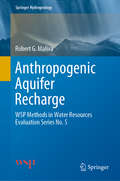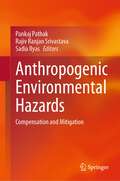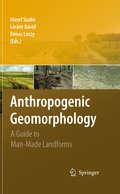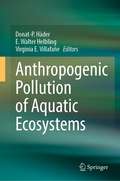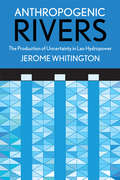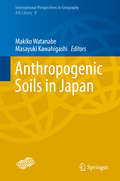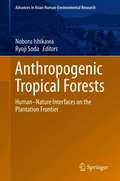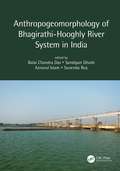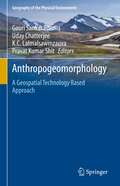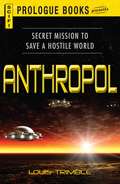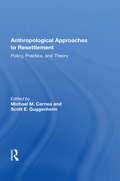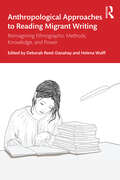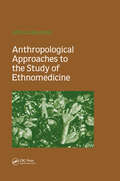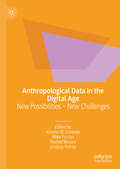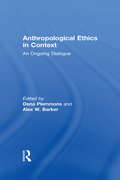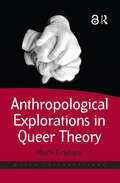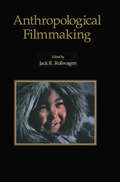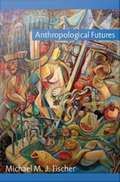- Table View
- List View
Anthropogenic Aquifer Recharge: WSP Methods in Water Resources Evaluation Series No. 5 (Springer Hydrogeology)
by Robert G. MalivaThe book is an overview of the diversity of anthropogenic aquifer recharge (AAR) techniques that use aquifers to store and treat water. It focusses on the processes and the hydrogeological and geochemical factors that affect their performance. This book is written from an applied perspective with a focus of taking advantage of global historical experiences, both positive and negative, as a guide to future implementation. Most AAR techniques are now mature technologies in that they have been employed for some time, their scientific background is well understood, and their initial operational challenges and associated solutions have been identified. However, opportunities exist for improved implementation and some recently employed and potential future innovations are presented. AAR which includes managed aquifer recharge (MAR) is a very important area of water resources management and there is no recent books that specifically and comprehensively addresses the subject.
Anthropogenic Environmental Hazards: Compensation and Mitigation
by Sadia Ilyas Pankaj Pathak Rajiv Ranjan SrivastavaThis book delves into the anthropogenic activities responsible for environmental hazards, their compensation, and potential mitigation strategies. It sheds light on the major contributors to the climate change issues aggravated by non-sustainable practices for the overexploitation of natural resources. Critical topics such as high emissions in primary mining, the recovery of energy-critical metals by urban mining, solid waste management, and forest conservation are explored, offering insights into the urgent challenges we face.Amidst the rapid demand for resources and the expansion of human habitats, the book emphasizes the need for new approaches to natural resource management and introspection of our actions. Experts in the field discuss existing anthropogenic environmental hazards in detail, alongside environmental compensation, and effective mitigation approaches.The book begins with a chapter dedicated to risk assessment in primary mining activities for precious metals, proposing potential routes for mitigation. Chapter 2 focuses on assessing and mitigating the environmental footprints of energy-critical metals used in permanent magnets. In Chapter 3, a case study examines sustainable resource utilization through end-of-life room air conditioner recycling. Additional chapters provide critical insights into:The environmental impacts of e-waste and government policies for responsible managementHazards associated with industrial effluents and corresponding mitigation strategiesThe role of roadside plants in phytoremediation of heavy metal pollutionSustainable utilization of anthropogenic coal fly ash through mechanical and chemical activationEnvironmental damages resulting from the mismanagement of municipal solid wasteEnvironmental problems and remediation strategies for anthropogenic biomass wasteChallenges in sustainable municipal solid waste management and suggestions for environmental risk mitigation The book concludes with a chapter discussing collaborative governance and non-monetary compensation mechanisms for sustainable forest management. Given its breadth, this book serves as an indispensable resource for researchers, policymakers, and environmental professionals seeking sustainable approaches to tackle pressing environmental challenges.
Anthropogenic Geomorphology: A Guide to Man-Made Landforms
by Denes Loczy József Szabó Lóránt DávidAnthropogenic geomorphology studies society's impact on the geographical environment, and especially on the Earth's surface. This volume provides guidance to students discussing the basic topics of anthropogenic geomorphology. The chapters cover both its system, and its connections with other sciences, as well as the way the subject can contribute to tackling today's practical problems. The book represents all fields of geomorphology, giving an introduction to the diversity of the discipline through examples taken from a range of contexts and periods, and focusing on examples from Europe. It is no accident that anthropogenic geomorphology has been gaining ground within geomorphology itself. Its results advance not only the theoretical development of the science but can be applied directly to social and economic issues. Worldwide, anthropogenic geomorphology is an integral and expanding part of earth sciences curricula in higher education, making this a timely and relevant text.
Anthropogenic Pollution of Aquatic Ecosystems
by Donat-P. Häder E. Walter Helbling Virginia E. VillafañeThis book provides examples of pollutants, such as accidental oil spills and non-degradable plastic debris, which affect marine organisms of all taxa. Terrestrial runoff washes large amounts of dissolved organic materials from agriculture and industry, toxic heavy metals, pharmaceuticals, and persistent organic pollutants which end up into rivers, coastal habitats, and open waters. While this book is not intended to encyclopaedically list all kinds of pollution, it rather exemplifies the problems by concentrating on a number of serious and prominent recent developments. The chapters in this book also discuss measures to decrease and remove aquatic pollution to mitigate the stress on aquatic organisms. Aquatic ecosystems provide a wide range of ecological and economical services. In addition to providing a large share of the staple diet for a fast growing human population, oceans absorb most of the anthropogenically emitted carbon dioxide and mitigate climate change. As well as rising temperatures and ocean acidification, pollution poses increasing problems for aquatic ecosystems and organisms reducing its functioning and services which are exposed to a plethora of stress factors.
Anthropogenic Rivers: The Production of Uncertainty in Lao Hydropower (Expertise: Cultures and Technologies of Knowledge)
by Jerome WhitingtonIn the 2000s, Laos was treated as a model country for the efficacy of privatized, "sustainable" hydropower projects as viable options for World Bank-led development. By viewing hydropower as a process that creates ecologically uncertain environments, Jerome Whitington reveals how new forms of managerial care have emerged in the context of a privatized dam project successfully targeted by transnational activists. Based on ethnographic work inside the hydropower company, as well as with Laotians affected by the dam, he investigates how managers, technicians and consultants grapple with unfamiliar environmental obligations through new infrastructural configurations, locally-inscribed ethical practices, and forms of flexible experimentation informed by American management theory.Far from the authoritative expertise that characterized classical modernist hydropower, sustainable development in Laos has been characterized by a shift from the risk politics of the 1990s to an ontological politics in which the institutional conditions of infrastructure investment are pervasively undermined by sophisticated ‘hactivism.’ Whitington demonstrates how late industrial environments are infused with uncertainty inherent in the anthropogenic ecologies themselves. Whereas ‘anthropogenic’ usually describes human-induced environmental change, it can also show how new capacities for being human are generated when people live in ecologies shot through with uncertainty. Implementing what Foucault called a "historical ontology of ourselves," Anthropogenic Rivers formulates a new materialist critique of the dirty ecologies of late industrialism by pinpointing the opportunistic, ambitious and speculative ontology of capitalist natures.
Anthropogenic Soils (Progress in Soil Science)
by Jeffrey HowardThis book is a state-of-the-art review of the physical, chemical and mineralogical properties of anthropogenic soils, their genesis morphology and classification, geocultural setting, and strategies for reclamation, revitalization, use and management.
Anthropogenic Soils in Japan (International Perspectives In Geography Ser. #9)
by Makiko Watanabe Masayuki KawahigashiThis book enhances the discussion of anthropized soils with photographs of soil profiles and provides general information about soils in Japan, using data on their physical and chemical properties. Soils targeted in this book have wide spectra in anthropized influences from lesser effects such as agricultural improvements to drastic changes caused by infrastructure construction. These include soils sealed by technic hard materials, on ski slopes, on river embankments and coastal berms, in historical urban parks, on man-made islands in Tokyo Bay, in reclaimed lands, in greenhouse fields, and those filling in swamplands. These examples supported with data can be a bridge between agriculture and civil engineering to understand how anthropogenic activities influence soils. Because anthropogenic impacts have increased during the past decades along with concentrations of populations into cities, processes in soils must be addressed from the point of view of diverse land-use purposes. The book includes information with new data produced by active researchers from many institutes and universities as it refers to soils altered by human activities and thus is informative to specialists in various disciplines related to soils. It is also valuable to students for viewing soils in cities, infrastructure construction areas, and other affected locations. Evaluation and understanding of soils now has become essential for researchers in a range of fields and for policy makers in agriculture as well as urban planning, civil engineering, and disaster sciences. This work serves as an impetus for launching further study of soils and environments.
Anthropogenic Tropical Forests: Human–Nature Interfaces on the Plantation Frontier (Advances in Asian Human-Environmental Research)
by Noboru Ishikawa Ryoji SodaThe studies in this volume provide an ethnography of a plantation frontier in central Sarawak, Malaysian Borneo. Drawing on the expertise of both natural scientists and social scientists, the key focus is the process of commodification of nature that has turned the local landscape into anthropogenic tropical forests. Analysing the transformation of the space of mixed landscapes and multiethnic communities—driven by trade in forest products, logging and the cultivation of oil palm—the contributors explore the changing nature of the environment, multispecies interactions, and the metabolism between capitalism and nature. The project involved the collaboration of researchers specialising in anthropology, geography, Southeast Asian history, global history, area studies, political ecology, environmental economics, plant ecology, animal ecology, forest ecology, hydrology, ichthyology, geomorphology and life-cycle assessment.Collectively, the transdisciplinary research addresses a number of vital questions. How are material cycles and food webs altered as a result of large-scale land-use change? How have new commodity chains emerged while older ones have disappeared? What changes are associated with such shifts? What are the relationships among these three elements—commodity chains, material cycles and food webs? Attempts to answer these questions led the team to go beyond the dichotomy of society and nature as well as human and non-human. Rather, the research highlights complex relational entanglements of the two worlds, abruptly and forcibly connected by human-induced changes in an emergent and compelling resource frontier in maritime Southeast Asia.
Anthropogeomorphology of Bhagirathi-Hooghly River System in India
by Balai Chandra DasThe Bhagirathi-Hooghly Basin in India is one of the most densely populated regions in the world and is undergoing rapid transformation of its natural landscape induced by human interventions, such as mushrooming of dams and barrages, deforestation, and urbanization. Human activities and interventions on basin landforms and the processes that shape those landforms have accelerated at an alarming rate. This book uses spatio-temporal analysis to understand the major anthropogenic signatures on land use and land cover changes and the impact these activities have on the landforms and processes of the Bhagirathi-Hooghly River and its sub-basins. It answers the what, where, why, and how of the anthropogenic signatures involved. Recent case studies on the impact of anthropogenic signatures on fluvial forms and processes make this book a useful resource for students and researchers in the earth sciences, local governments, urban planners, and all concerned with rural developments. Features: Explores for the first time the new concept of anthropogeomorphology for the river basin—an emerging field Analyses the impact of anthropogenic activities, especially the construction of dams and reservoirs, and urbanization on major fluvial landscapes using advanced geospatial modelling techniques Investigates human interference in river systems, their effects on the dynamics of the river, and the livelihoods of the people residing along the river Addresses issues related to geology, geomorphology, geography, planning, land use, and land management areas Fills the need for data-driven governance and policy decisions for the future of urban-industrial growth in India.
Anthropogeomorphology: A Geospatial Technology Based Approach (Geography of the Physical Environment)
by Gouri Sankar Bhunia Pravat Kumar Shit Uday Chatterjee K. C. LalmalsawmzauvaThis book explores state-of-art techniques based on open-source software and statistical programming and modelling in modern geospatial applications, specifically focusing on recent trends in data mining techniques and robust modelling in Geomorphological, Hydrological, Bio-physical and Social activities. The book is organized into physical, mountainous, coastal, riverine, forest, urban and biological activities, with each chapter providing a review of the current knowledge in the focus area, and evaluating where future efforts should be directed. The text compiles a collection of recent developments and rigorous applications of Geospatial computational intelligence (e.g., artificial neural network, spatial interpolation, physical and environmental modelling and machine learning algorithms etc) in geomorphic processes from a team of expert contributors. The authors address the wide range of challenges and uncertainties in the study of earth system dynamics due to climate change, and complex anthropogenic interferences where spatial modelling may be applied in the risk assessment of vulnerable geomorphological landscapes. The book will act as a guide to find recent advancements in geospatial artificial intelligence techniques and its application to natural and social hazards. This information will be helpful for students, researchers, policy makers, environmentalists, planners involved in natural hazard and disaster management, NGOs, and government organizations.
Anthropol
by Louis TrimbleIt’s an urgent assignment for Vernay: get control of the totalitarian government of Ujvila. Hard enough, but Vernay’s also got to do it before Galactic-Military solves the problem its own way: by slamming in an invasion force and destroying half the planet. The natives of Anthropol don’t like aliens and they don’t want Vernay. So it’s going to be a tough assignment. One of the toughest of his career.
Anthropol
by Louis TrimbleIt's an urgent assignment for Vernay?get control of the totalitarian government of Ujvila. Hard enough, but Vernay's also got to do it before Galactic-Military solves the problem its own way: by slamming in an invasion force and destroying half the planet.The natives of Anthropol don't like aliens and they don't want Vernay. So it's going to be a tough assignment.One of the toughest of his career.
Anthropol
by Louis TrimbleIt’s an urgent assignment for Vernay?get control of the totalitarian government of Ujvila. Hard enough, but Vernay’s also got to do it before Galactic-Military solves the problem its own way: by slamming in an invasion force and destroying half the planet.The natives of Anthropol don’t like aliens and they don’t want Vernay. So it’s going to be a tough assignment.One of the toughest of his career.
Anthropological Approaches To Resettlement: Policy, Practice, And Theory
by Michael M. Cernea Scott E. GuggenheimThis book is about people who have been forced resettle because of development projects. It takes stock of recent applied social science research on involuntary resettlement and forms a part of an international discussion on theories of resettlement and what social scientists can do about it.
Anthropological Approaches to Reading Migrant Writing: Reimagining Ethnographic Methods, Knowledge, and Power
by Deborah Reed-Danahay Helena WulffThis book brings fresh perspectives to the anthropology of migration. It focuses on what migrants write and how anthropologists may incorporate insights gained from engagement with this writing into research methods and writing practices. The volume includes a range of contributions from leading scholars in the field, all organized around a striking set of questions about the conditions in which migrant narratives are written and translated, the audiences for which they are intended, the genres and media through which they are disseminated, and what such stories include or leave out. The contributors to this volume demonstrate an innovative shift in anthropological methods by showing how fiction and nonfiction, graphic memoir and autoethnography, song lyrics, as well as social media posts and images unsettle the power dynamics in the study of migration narrative. This book will serve as important supplemental reading for courses on migration, literary anthropology, ethnographic methods, and sociocultural anthropology in general. Its interdisciplinary perspective will appeal to a broad range of scholars and students with interests in migration, narrative, and anthropological writing genres.
Anthropological Approaches to the Study of Ethnomedicine
by Mark NichterFirst Published in 1992. The reader of this volume will see how a decade of new work has remade ethnomedicine into one of the livelier and more promising domains of anthropology. Nicthter's encompassing redefinition of the relationship of ethnomedicine to medical anthropology and his critical comments that introduce each chapter are bound to provoke discussion and response over the years to come. - Arthur Kleinman, MD Harvard Medical School.
Anthropological Approaches to the Study of Religion
by Michael BantonAs the basic questions of social structure were elucidated there came a quickening of interest among social anthropologists in the study of religion. Chapters in this book include: · Religion as a Cultural System (Clifford Geertz) · Colour Classification in Ndembu Religion (Victor W. Turner) · Religion: Problems of Definition and Explanation (Melford E. Spiro) · Fathers, Elders and Ghosts in Edo Religion (R.E. Bradbury) · Territorial Groupings and Relgion among the Iraqw (Edward H. Winter). First published in 1966.
Anthropological Archaeology Underwater (Elements in Anthropological Archaeology in the 21st Century)
by Ashley LemkeAnthropological archaeology underwater is a new field. What type of research is this and how do anthropologists go about it? When most people hear the phrase 'underwater archaeology', they think of shipwrecks and dramatic images of lost ships at sea, but the underwater archaeological record is vast. In addition to historic vessels, water preserves some of the oldest landscapes on the planet. While archaeologists are interested in the past, those working underwater apply the latest technologies to provide fresh understandings about ancient human behaviour. Underwater environments provide preservation that is unmatched on land and therefore the data collected is novel – providing information about human lifeways and creating a picture of the past we would otherwise never see. This Element will explore the world of anthropological archaeology underwater, focusing on submerged sites, and review the techniques, data, and theoretical perspectives which are offering new insights into the human story.
Anthropological Controversies: The “Crimes” and Misdemeanors that Shaped a Discipline
by Gavin Weston Natalie DjohariThis book uses controversies as a gateway through which to explore the origins, ethics, key moments, and people in the history of anthropology. It draws on a variety of cases including complicity in "human zoos", Malinowski’s diaries, and the Human Terrain System to explore how anthropological controversies act as a driving force for change, how they offer a window into the history of and research practice in the discipline, and how they might frame wider debates such as those around reflexivity, cultural relativism, and the politics of representation. The volume provokes discussion about research ethics and practice with tangible examples where gray areas are brought into sharp relief. The controversies examined in the book all involve moral or practical ambiguities that offer an opportunity for students to engage with the debate and the dilemmas faced by anthropologists, both in relation to the specific incidents covered and to the problems posed more generally due to the intimate and political implications of ethnographic research.
Anthropological Data in the Digital Age: New Possibilities – New Challenges
by Jerome W. Crowder Mike Fortun Rachel Besara Lindsay PoirierFor more than two decades, anthropologists have wrestled with new digital technologies and their impacts on how their data are collected, managed, and ultimately presented. Anthropological Data in the Digital Age compiles a range of academics in anthropology and the information sciences, archivists, and librarians to offer in-depth discussions of the issues raised by digital scholarship. The volume covers the technical aspects of data management—retrieval, metadata, dissemination, presentation, and preservation—while at once engaging with case studies written by cultural anthropologists and archaeologists returning from the field to grapple with the implications of producing data digitally. Concluding with thoughts on the new considerations and ethics of digital data, Anthropological Data in the Digital Age is a multi-faceted meditation on anthropological practice in a technologically mediated world.
Anthropological Ethics in Context: An Ongoing Dialogue
by Alex W Barker Dena PlemmonsThis volume examines general ethical principles and controversies in the social sciences by looking specifically at the recent three-year revision process to the American Anthropological Association’s code of ethics. The book’s contributors were members of the task force that undertook that revision and thus have first-hand knowledge of the debates, compromises, and areas of consensus involved in shaping any organization’s ethical vision. The book-reflects the broad diversity of opinion, approach, and practice within anthropology and the social sciences;-develops ethical principles that reflect core values rather than the latest ethical controversies;-crafts clear, broad statements, increasing the likelihood that the ethical code will be a meaningful part of the daily discourse of practicing anthropologists;-develops the ethical code as a living document, or a process of experience and debate, subject to future revision and amplification;-provides explanation through internet links and other resources, ensuring that the finished product be relevant and vibrant.
Anthropological Expertise and Legal Practice: In Conversation (Law and Anthropology)
by Brian Donahoe Maria Sapignoli Marie-Claire FobletsThis book draws on concrete cases of collaboration between anthropologists and legal practitioners to critically assess the use of anthropological expertise in a variety of legal contexts from the point of view of the anthropologist as well as of the decision-maker or legal practitioner. The contributions, several of which are co-authored by anthropologist–legal practitioner tandems, deal with the roles of and relationships between anthropologists and legal professionals, which are often collaborative, interdisciplinary, and complementary. Such interactions go far beyond courts and litigation into areas of law that might be called ‘social justice activism’. They also entail close collaboration with the people –often subjects of violence and dispossession –with whom the anthropologists and legal practitioners are working. The aim of this collection is to draw on past experiences to come up with practical methodological suggestions for facilitating this interaction and collaboration and for enhancing the efficacy of the use of anthropological expertise in legal contexts. Explicitly designed to bridge the gap between theory and practice, and between scholarship and practical application, the book will appeal to scholars and researchers engaged in anthropology, legal anthropology, socio-legal studies, and asylum and migration law. It will also be of interest to legal practitioners and applied social scientists, who can glean valuable lessons regarding the challenges and rewards of genuine collaboration between legal practitioners and social scientists.: The Open Access version of this book, available at http://www.taylorfrancis.com, has been made available under a Creative Commons [Attribution-Non Commercial-No Derivatives (CC BY-NC-ND)] 4.0 license.
Anthropological Explorations in Queer Theory (Queer Interventions)
by Mark GrahamAnthropological Explorations in Queer Theory offers a wide ranging fusion of queer theory with anthropological theory, shifting away from the discussion of gender categories and identities that have often constituted a central concern of queer theory and instead exploring the queer elements of contexts in which they are not normally apparent. Engaging with a number of apparently 'non-sexual' topics, including embodiment and fieldwork, regimes of value, gifts and commodities, diversity discourses, biological essentialisms, intersectionality, the philosophy of Bergson and Deleuze, and the representation of heterosexuality in popular culture, this book moves to discuss central concerns of contemporary anthropology, drawing on both the latest anthropological research as well as classic theories. In broadening the field of queer anthropology and opening queer theory to a number of new themes, both empirical and theoretical, Anthropological Explorations in Queer Theory will appeal not only to anthropologists and queer theorists, but also to geographers and sociologists concerned with questions of ontology, materiality and gender and sexuality.
Anthropological Filmmaking: Anthropological Perspectives on the Production of Film and Video for General Public Audiences (Visual Anthropology)
by Jack R. RollwagenFirst Published in 1988. Visual Anthropology is a book series devoted to the illumination of the human condition through a systematic examination of all that is made to be seen. It is our intention to demonstrate the value of an anthropological approach to the study of the visual and pictorial world. The anthropological filmmaker, just like the ethnographer, must be content to present something about a dynamic process at a particular moment in time regardless of the fact that all of the variables are constantly in flux. The purpose of this work is to make available a collection of articles by individuals who are both anthropologists and filmmakers.
Anthropological Futures
by Michael M. J. FischerIn Anthropological Futures, Michael M. J. Fischer explores the uses of anthropology as a mode of philosophical inquiry, an evolving academic discipline, and a means for explicating the complex and shifting interweaving of human bonds and social interactions on a global level. Through linked essays, which are both speculative and experimental, Fischer seeks to break new ground for anthropology by illuminating the field's broad analytical capacity and its attentiveness to emergent cultural systems. Fischer is particularly concerned with cultural anthropology's interactions with science studies, and throughout the book he investigates how emerging knowledge formations in molecular biology, environmental studies, computer science, and bioengineering are transforming some of anthropology's key concepts including nature, culture, personhood, and the body. In an essay on culture, he uses the science studies paradigm of "experimental systems" to consider how the social scientific notion of culture has evolved as an analytical tool since the nineteenth century. Charting anthropology's role in understanding and analyzing the production of knowledge within the sciences since the 1990s, he highlights anthropology's aptitude for tracing the transnational collaborations and multisited networks that constitute contemporary scientific practice. Fischer investigates changing ideas about cultural inscription on the human body in a world where genetic engineering, robotics, and cybernetics are constantly redefining our understanding of biology. In the final essay, Fischer turns to Kant's philosophical anthropology to reassess the object of study for contemporary anthropology and to reassert the field's primacy for answering the largest questions about human beings, societies, culture, and our interactions with the world around us. In Anthropological Futures, Fischer continues to advance what Clifford Geertz, in reviewing Fischer's earlier book Emergent Forms of Life and the Anthropological Voice, called "a broad new agenda for cultural description and political critique. "
